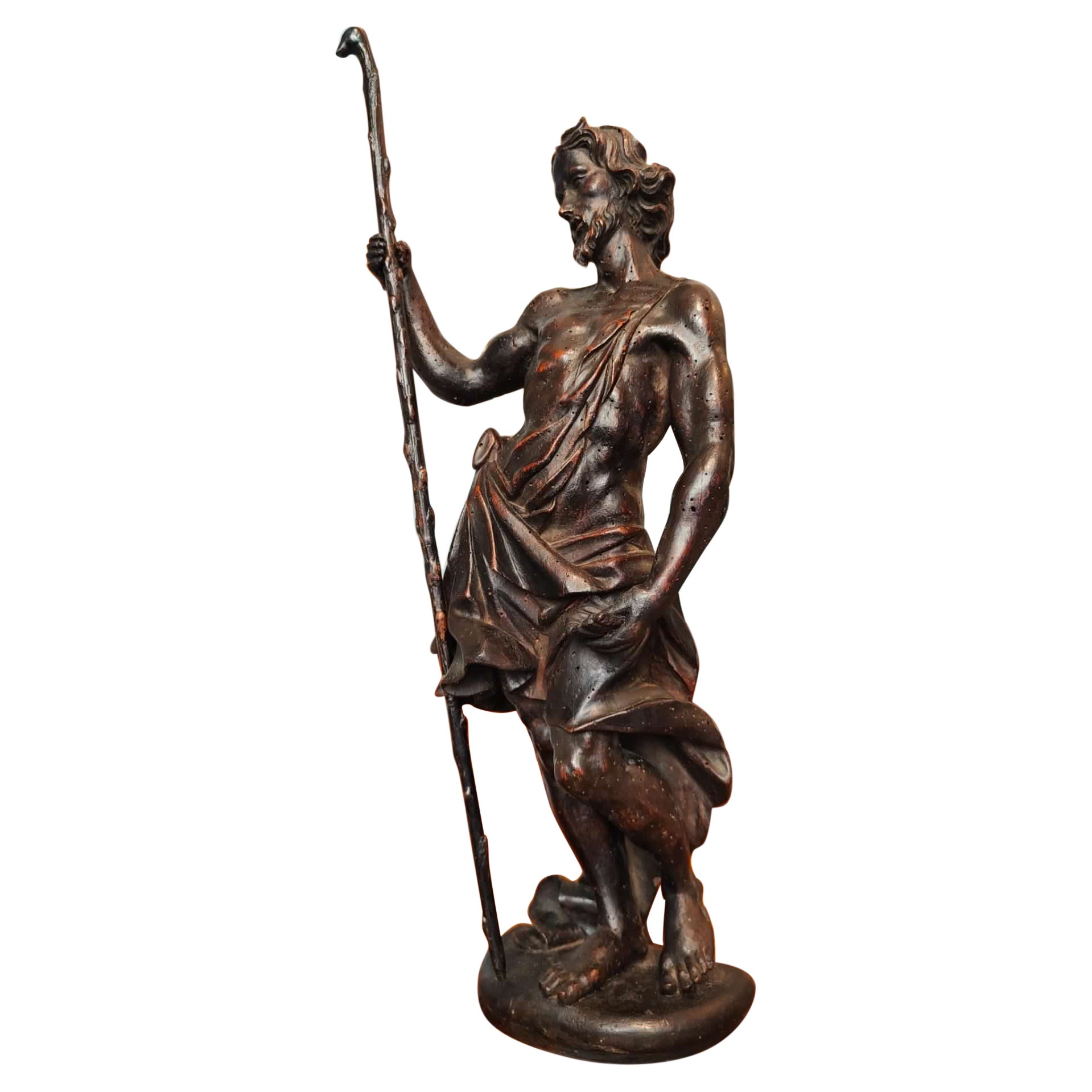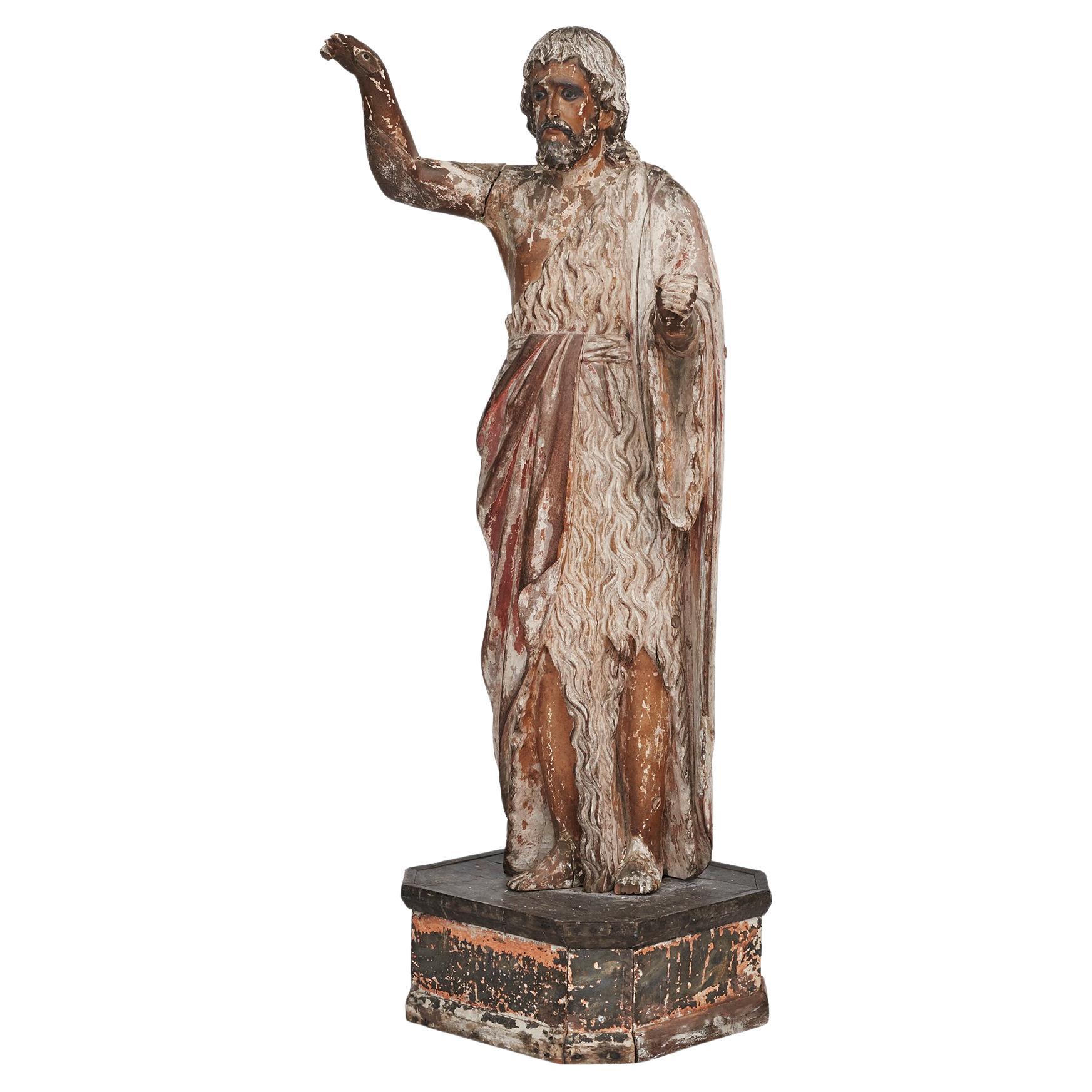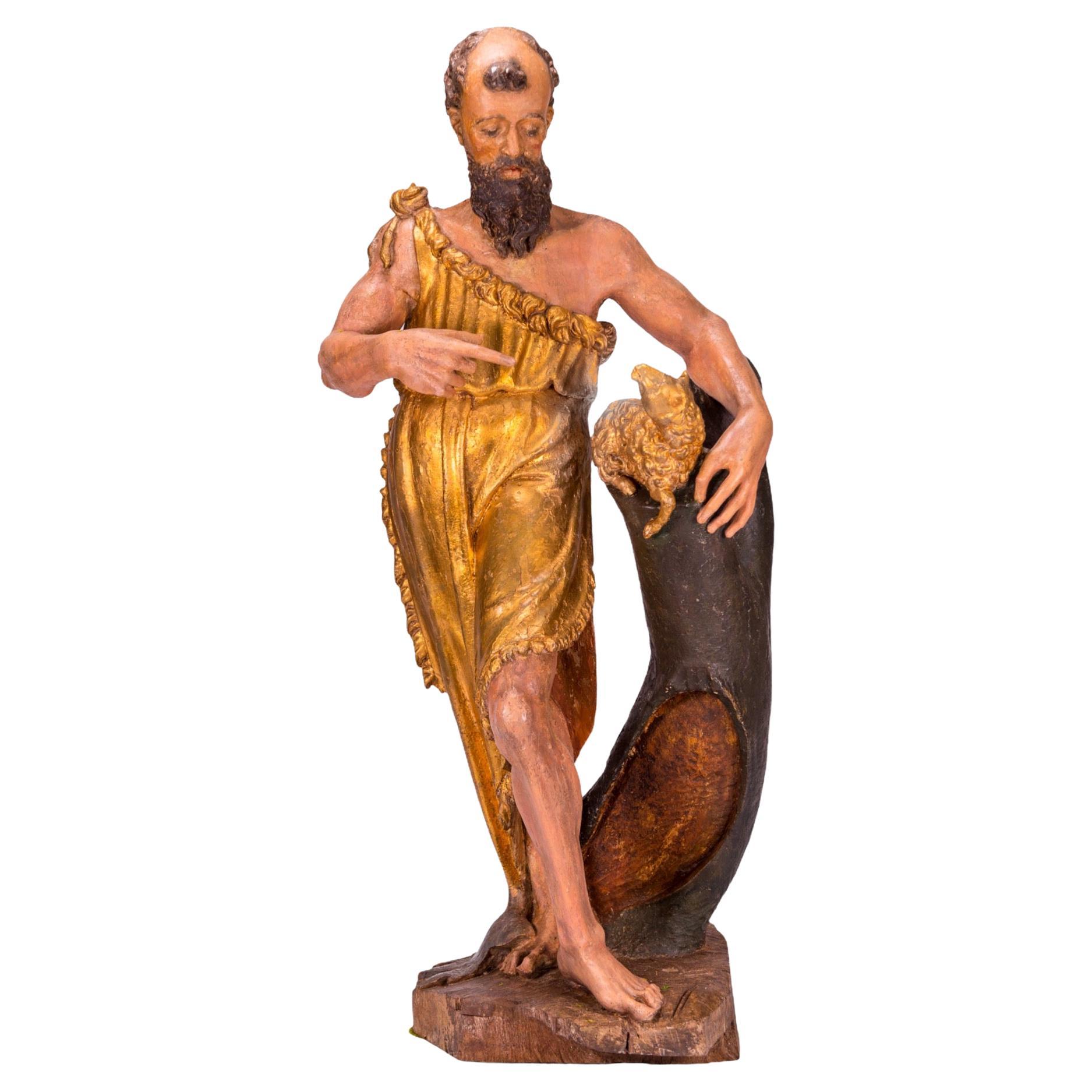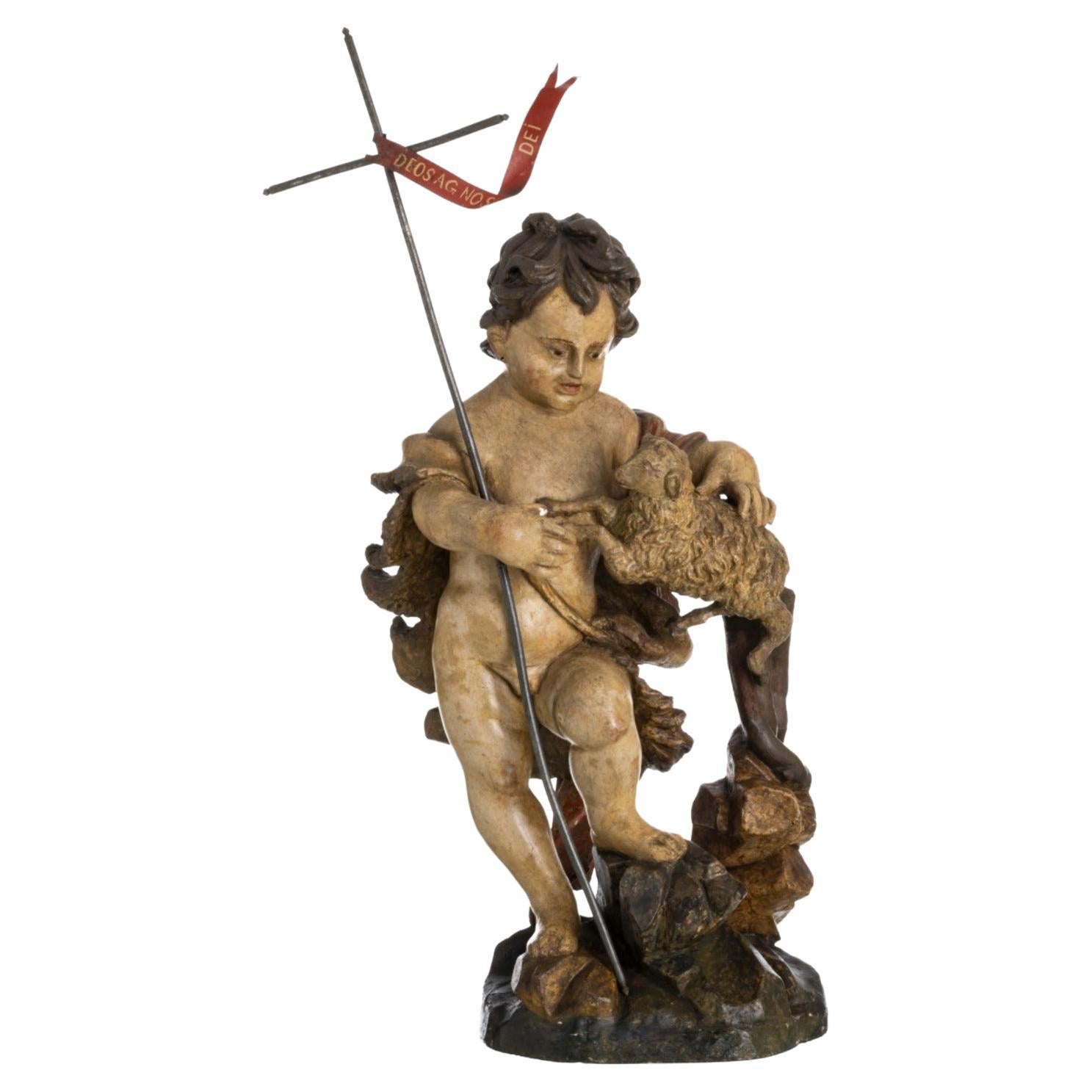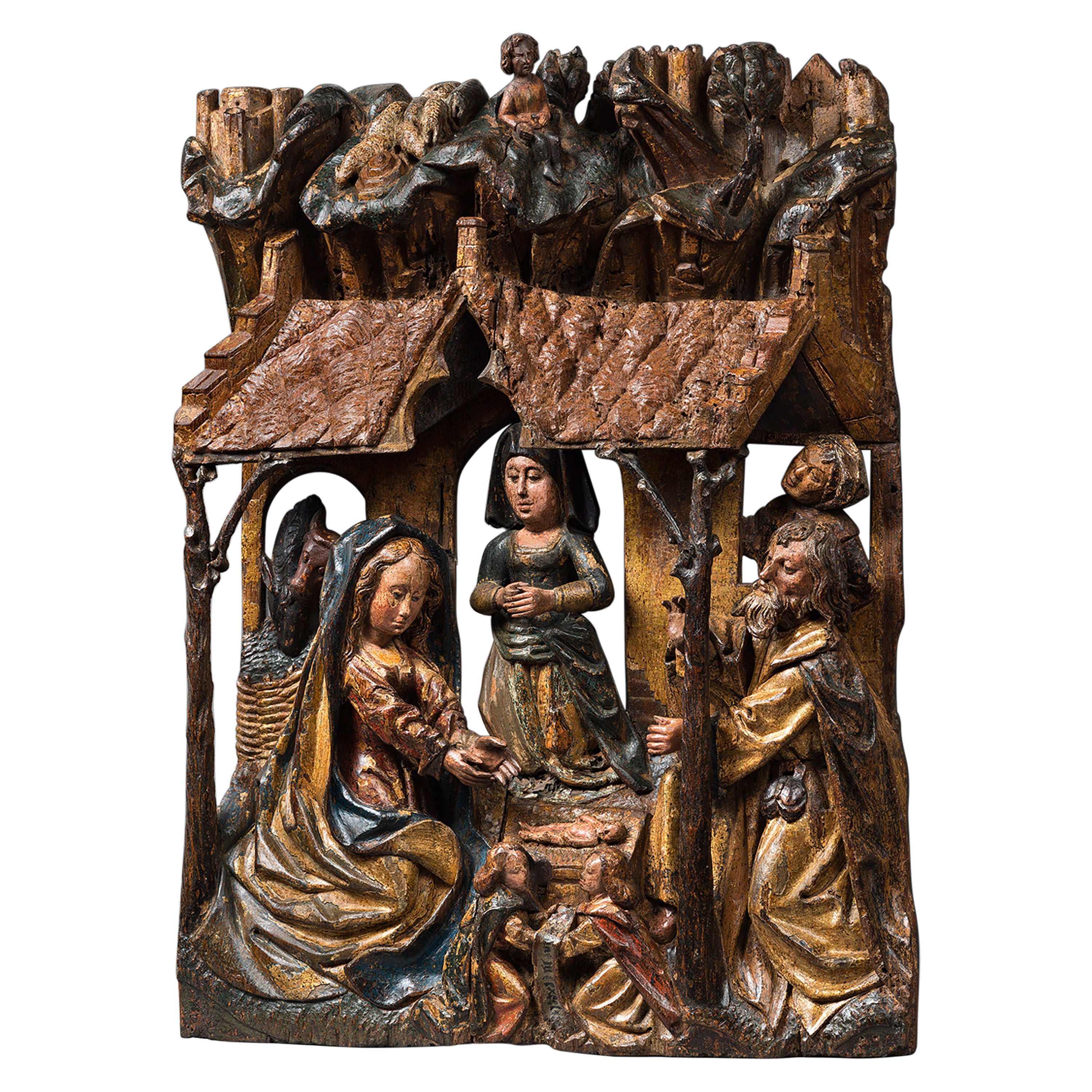Items Similar to Wood Sculpture Depicting John the Baptist
Want more images or videos?
Request additional images or videos from the seller
1 of 6
Wood Sculpture Depicting John the Baptist
About the Item
This wood scultpure showing fine traces of polychromy depicts John the Baptist, one the Old Testament’s last prophets and the first martyr of the New Testament. He is easily recognizable with the lamb he is carrying in his left hand. The way the artist has carved the face exudes a spiritual strenght inherited from previous centuries.
Description
Saint John the Baptist is depicted bare feet, seated in a hieratic manner. His elongated face is marked by a beard and a moustache. The straight nose and wide eyes indicate a Spanish origin. This asumption is reaffirmed by the Saint’s resigned expression.
His parted hair frames his face while uncovering his ears.
He wears a round collar red-orange tunic, draped onto the body and belted at the waist. A flap of his green coat covers his knees and falls down in stylized pleats.
Following iconographic rules Saint John the Baptist is pointing with his right hand the lamb seated over the book he holds in his left hand. This depiction echoes what the Saint said before Jesus’ baptism « Look, the Lamb of God, who takes away the sin of the world! » John 1 : 29.
The 14th century in Spain is known as an artistic transition period. Sculpture maintains characteristics from previous centuries as well as establishing new visual solutions.
The hieratic posture of our Saint John the Baptist, his elongated proportions, the respect of the Eastern symbolism of the hand gesture as well as his exophthalmos and supple drapes are clearly characteristics from the 13th century.
However the clothe’s pleats show an evolution from previous era. Even though the cloth lacks in natural it shows the artist’s interest for weight and draping.
Those different points – union between tradition and evolution – allow us to date this sculpture around the late 13th century and early 14th century.
Life of Saint John the Baptist
John the Baptist was the son of Elizabeth, cousin of the Virgin, and of Zechariah an old priest. He was the cousin of Jesus Christ.
When he was in his teenage years John went to the Judean desert to lead an ascetic life, feeding from locusts and preaching penance until the coming of Jesus, the Messiah, by the Jordan river. Jesus asked John to give him baptism and with this event begins Jesus’ preaching. His preachings caused general effervescence among the people leading to his arrest.
Saint John the Baptist was imprisoned in 29AD by Herod Antipas, tetrach of Galilee, because of his opposition to Herod’s wedding with Herodiad his niece and sister-in-law. Salome, daughter of Herodiad, asked for John’s head after giving the tetrarch an appealing dance and thus the Saint is beheaded.
John the Baptist, sometimes called John the Forerunner, is the first among the hierarchy of Saints and his primacy is recognized by liturgy. The numerous relics and churches bearing his name across the globe express the Saint’s popularity.
Literature
Jacqueline LIEVEAUX-BOCCADOR, Edouard BRESSET, Statuaire médiévale de collection, Tome I, Les clefs du temps, Milan, 1972.
- Dimensions:Height: 39.38 in (100 cm)Width: 11.03 in (28 cm)Depth: 3.94 in (10 cm)
- Style:Gothic (Of the Period)
- Materials and Techniques:
- Place of Origin:
- Period:
- Date of Manufacture:Late 13th-Early 14th Century
- Condition:Wear consistent with age and use. Minor losses. Minor structural damages. Minor fading.
- Seller Location:Saint-Ouen, FR
- Reference Number:1stDibs: LU3115327272042
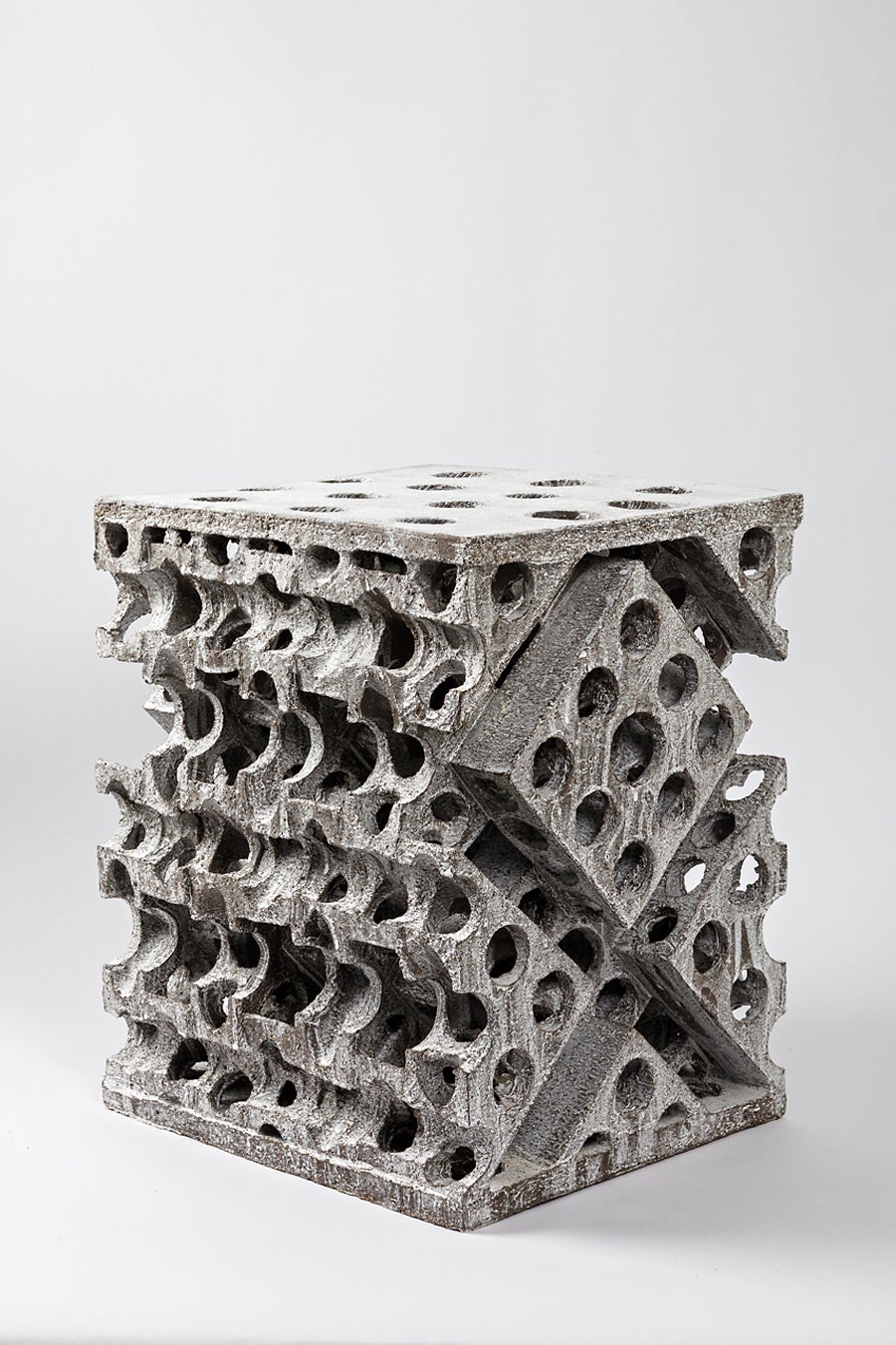
About the Seller
5.0
Vetted Seller
These experienced sellers undergo a comprehensive evaluation by our team of in-house experts.
Established in 2016
1stDibs seller since 2017
158 sales on 1stDibs
Typical response time: 8 hours
- ShippingRetrieving quote...Ships From: Saint-Ouen, France
- Return PolicyThis item cannot be returned.
More From This SellerView All
- Late 15th Century Polychrome Wood Carving Depicting the NativityLocated in Saint-Ouen, FRWhile the birth of Christ is briefly told in the Gospel of Luke (2, 7) it is in the apocryphal texts that we find most of the elements and details that have then inspired artists. As of the 14th century and even more of the 15th century the subject of the Adoration of the Child replaces in Western art the scene of the Birth, much favoured in Byzantine art. Instead of being depicted lying with the new-born swathed in the manger, the Virgin is now kneeling, her hands joined in prayer in front of the naked child. This change was probably hastened by the popularity of the visions of Saint Bridget of Sweden to whom the Virgin allegedly appeared to show how she had given birth to Jesus (Visions, VII, chap. 21). Sheltered by a thatch-roofed structure the Virgin is kneeling in front of the Child Jesus. She wears a magnificent red dress under a large gold cloak. Her curled blond hair is partially veiled. The newborn is lying on a straw mat. Joseph is depicted with a parted beard and stands opposite from the Virgin. He wears a tunic and a coat with a purse hanging from the belt. His costume reminds us of the long journey him and Mary have accomplished to reach Bethlehem. Two other women are present. One is looking through the stable’s window to observe the Holy Family while another one kneels in prayer in front of the divine child. The rich costume of the lady might indicate she is a donator. However they could also both represent the women who took part in the birth of Christ, Zelemi and Salome. Salome, incredulous did not believe in the virginal conception of Mary and she is represented far from the scene. The artist has depicted her with an expression of doubt on her face. Zelemi, on the contrary, is a believer. She is rewarded by a place of honour at the heart of the scene, close to Mary. To the left the donkey and ox that have accompanied Mary and Joseph to Bethlehem observe quietly the scene. On the foreground two angels hold a scroll reading an excerpt from the Gloria : “/Gloria/ in excelsis /Deo/.” One of the angels wears a blue cape while the other’s is red Those two colours are very significant as during Middle-Ages blue symbolises hope and red charity. Together they express the hope in redemption thanks to the advent of Christ and his sacrifice to come. Above the main scene, up a cliff, a small shepherd lets his herd of sheep graze amidst the trees. He is framed by two walled cities. This wood carving is the work of a very skilled and inventive artist. The piece bears witness to his exceptional talent. The realism of the scene is emphasised by the amount of details depicted. The refinement of the carving itself is highlighted by the well preserved polychromy. This key moment of the New Testament is set in a contemporary context thanks to the clothes of the characters and the scenes of rural life. The universal dimension of the scene is intensified while allowing contemporary viewers to grasp its meaning more easily. This care for details, the picturesque realism as well as the extraordinary rendition of the cloths suggest it was made by a Flemish artist during the late 15th century. This relief can be compared with the panel of the Nativity from the Saint-Vaast altarpiece made by Jacques Daret between 1433 and 1435, today in Madrid’s Thyssen-Bronemisza Museum. Literature Louis Réau, Iconographie de l’Art chrétien...Category
Antique 15th Century and Earlier Dutch Gothic Figurative Sculptures
MaterialsWood
- 15th Century Carved Wood Depicting Saint JamesLocated in Saint-Ouen, FRThe Saint depicted here is Saint James the Great. James is the brother of St. John the Evangelist. Nothing is known of his activities after the Ascension...Category
Antique 15th Century and Earlier French Gothic Figurative Sculptures
MaterialsOak
- 15th Century Burgundian Low-Relief Depicting Scenes of the NativityLocated in Saint-Ouen, FRProvenance : In the same private collection for several generations, Burgundy. The canonical Gospels describe briefly the episode of the Nativity. It comprises three parts : • The Preludes : the Journey to Bethlehem, the Census • The Nativity • The Announce to the Shepherds and the Adoration of the Magi Only the Gospel according to Matthew (2, 1-12) speaks about the Adoration of the Magi. Staying vague about their number it does say they brought the newborn gold, incense and myrrh. The apocryphals, the fathers of the Church and many other authors have filled in the gaps of the evangelic tale. The sobriety and symbolic of the story have been a huge inspiration to artists. Although one of the oldest depictions of the Adoration of the Magi dates from the 2nd century the theme became very popular in Christian art during the late 14th century. One of the reasons explaining this success is that it celebrates both the Virgin and Christ at the same time. This important walnut panel is carved in a strong relief and depicts the different steps of the story of Jesus’ birth. On the left, the donkey and ox that have accompanied Mary and Joseph from Bethlehem are depicted behind a trough. On the thatch roof appears the star that would guide the magi to the place of birth of Jesus. Mary is wearing a veil and is seating on a bed. She holds her baby at arm’s length to present him to the magi. Saint Joseph is by her side. The old man is holding a cane in his left hand while from the right hand he seems to uncover himself to greet the visitors. A woman assists to the scene. In front of the holy family the three magi stand behind one another to pay their homage to the newborn. The first magi has a pointed beard. He is already kneeling out of deference and has placed his crown to his feet. He gives the baby a hanap filled with gold coins. This is Melchior as the legend describes him with white hair and a long beard. Caspar, the second magi bears a cup of incense. He is looking at the third magi and with his right hand he points to the star that has guided them there. He has a short beard and wears crakow shoes, breeches and a wide sleeved doublet. Finally Balthazar, the elegant last magi proceeds proudly towards the holy family with his one hand on the saber’s hilt and the other holding a cup. He brings the divine child the myrrh. He probably just dismounted as the horse can be seen behind him. The scene is set in a very detailed and narrative decor. In the right part of the panel the shepherd receive the announce of Jesus’ birth. An angel comes down from heaven with a scroll bearing the good news in his hands. The herding dog sleeps peacefully while sheeps graze. At the top of the cliff we notice the gilded sheeps enclosure. The panel’s moulded frame is carved with a foliated decor. In it’s centre appears a coat-of-arms. It is the alliance of the three magi’s arms. Indeed as it was common for legendary figures the three of them received imaginaries coat-of-arms. Thus, on a field of azure stands a star for Melchior, a crescent for Caspar and a pennon for Balthazar. This high-relief panel is undeniably the work of a very skilled and imaginative artist. This key moment in the New Testament is transposed to a contemporary environment thanks to the figures’ clothing and the rural daily life scene. This way the universal dimension of the episode is highlighted allowing a better understanding for the contemporaries. The sculptor has represented the episodes of the Adoration of the Magi and the Announce to the Shepherd with great talent and numerous details giving life to a picturesque and narrative scene. The important traces of polychromy give those already very animated scenes a stronger pictorial power and a rich dynamism. Because of the picturesque and familiar realism so dear to the artists of the late Medieval era, of the didactic function of this type of panel as well as the quality of the sculpture this piece is an astounding example of Burgundian art of the 15th century. Literature Louis Réau, Iconographie de l’Art chrétien...Category
Antique 15th Century and Earlier French Gothic Figurative Sculptures
MaterialsWalnut
- Carved Wood Depicting the Resurrection of ChristLocated in Saint-Ouen, FRCarved wood depicting the resurrection of Christ ORIGIN : SOUTHERN NETHERLANDS, ANTWERP PERIOD : EARLY 16th CENTURY Height : 67.5 cm Len...Category
Antique 16th Century Figurative Sculptures
MaterialsOak
- Important Wood Sculpture, Gothic Depiction of Saint WenceslausLocated in Saint-Ouen, FRIMPORTANT WOOD SCULPTURE, GOTHIC DEPICTION OF SAINT WENCESLAUS ORIGIN : CENTRAL EUROPE PERIOD : MID-15th CENTURY Height : 83 cm Length : 30 cm Depth : 20 cm Basswood Good condit...Category
Antique 15th Century and Earlier Figurative Sculptures
MaterialsWood
- Beautiful Sculpture Depicting Saint George Slaying the DragonLocated in Saint-Ouen, FRBEAUTIFUL SCULPTURE IN POLYCHROME LINDEN REPRESENTING SAINT GEORGE SLAYING THE DRAGON ORIGIN : SOUTHERN GERMANY, SWABIA PERIOD : LATE 15th CENTURY Polychrome linden wood, silvered flange Measures: Height : 104 cm Width : 21 cm Good state of conservation, original polychromy HISTORICAL Officer in the Roman army, Saint George passed through a city plagued by a voracious dragon that devoured its inhabitants. To appease the monster's hunger, the villagers offered him sheep, but when all the cattle were sacrificed, two young people were drawn. One day, fate designated the king's daughter, forced to be delivered to the dragon. Initiating a fight to save her, Saint George, on his horse, triumphed over the monster by piercing it with his spear. In order to symbolize the victory of faith over Evil, the different versions of the legend end with the death of the dragon. However, the Golden Legend, by Jacques de Voragine affirms that the creature was only wounded and that the saint would have dragged it, chained, at his side. Before leaving the city, Saint George distributed to the poor the money that the king had given him as a reward. After his victory over the dragon, came the passion of the saint. Indeed, Saint George was martyred for refusing to sacrifice to pagan idols during the persecution of Diocletian. The saint suffered numerous physical abuses from which he miraculously survived. He was eventually beheaded and his holy body was retrieved by an angel. DESCRIPTION This polychrome sculpture represents Saint George standing, his foot on the dragon which he strikes down with a spear. This image is one of the most evocative of the iconography of Saint George. He is represented young and beardless, in infantry armor, typically German, due to the length of the poacher who protects the thighs of the saint. The armor covers his whole body, from the neck, with the gorget, to the foot with the sabatons. The armor is realistic thanks to the precision of the parts composing it and this silver highlight which gives it a patina with metallic reflections The saint is wearing a hood with raised brown edges, revealing curly hair down to the bottom of his neck. The face of the saint seems serene, and his attitude controlled, a symbol of chivalrous virtues. Concerning the posture, Saint George raises his right arm and bends the left in order to plant his spear in the mouth of the dragon. He is in contrapposto, his left foot crushing the long neck of the monster. The dragon, on the other hand, is salamander-like with large, pointed ears and a large, jagged crest on its back. The creature opens its mouth and twists its neck in pain. A green color covers its skin, and highlights of red are located inside its mouth and ears. This exceptional piece is the reflection of a remarkable sculptural work, due to the harmony that emerges from the composition, the precision of the details and expressions, as well as the contribution of the polychromy that animates this scene. LITERATURE Louis Réau, Iconographie de l’Art Chrétien...Category
Antique 15th Century and Earlier Figurative Sculptures
MaterialsWood
You May Also Like
- Sculpture depicting St. John the BaptistLocated in Alba, ITWooden sculpture of remarkable quality depicting St. John the Baptist shown with staff and shell in his left hand. The figure is defined and cared for in every detail, and even small...Category
Antique 17th Century Italian Other Busts
MaterialsWood
- Large Religious Wood Figure "John the Baptist"Located in Kastrup, DKA wood carved baroque figure depicting John the Baptist (also called Johannes the Baptist) with original polychrome paint. Height: 152 cm. Originates...Category
Antique 18th Century Philippine Baroque Figurative Sculptures
MaterialsHardwood
- Sculpture of John The Baptist, 16th CenturyLocated in North Miami, FLEarly 16th Century Spanish gold gilded and polychromed carved wood sculpture of John The Baptist.Category
Antique 16th Century Spanish Renaissance Figurative Sculptures
MaterialsGold Leaf
- Saint John the Baptist Sculpture, 18th CenturyBy Europa AntiquesLocated in Madrid, ESSaint John the Baptist 18th century Portuguese sculpture from the 18th century. in polychrome wood. The figure is represented standing with the lamb. Small flaws. Measure: ...Category
Antique 18th Century Portuguese Renaissance Figurative Sculptures
MaterialsWood
- Spanish Majolica Statue of John the BaptistLocated in London, GBA Spanish (Catalan) tin glazed Majolica statue of St. John the Baptist.Category
Antique 1860s Spanish Figurative Sculptures
MaterialsMajolica
- Wood Sculpture Depicting a MuttonLocated in bari, ITFinely refined natural size wood sculpture depicting a mutton.Category
Vintage 1950s Italian Mid-Century Modern Animal Sculptures
MaterialsWood
